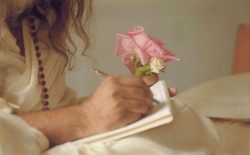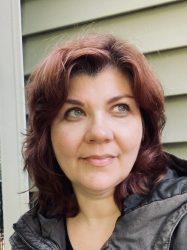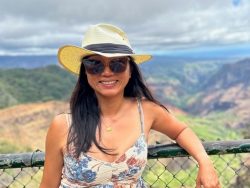Finding Her Personal Voice: Artist Mindy Weisel’s Journey

For a writer, finding your personal voice is one of the most important parts of mastering the craft. It turns out that this is also important for visual artists such as Mindy Weisel.
An oil painter who in recent years has turned to glass as a medium, Mindy Weisel has shown her work in solo shows in prestigious galleries and is the recipient of numerous awards. Her art appears in the Hirshhorn Museum, the National Museum of American Art, the Israel Museum, the U.S. Embassy, the Baltimore Museum of Art, and the Archives of American Artists at the Smithsonian Institution.
Yet despite her success, Mindy says she struggled emotionally with each piece to discover what she wanted to say. She feels this struggle has its roots in her unusual childhood.
Born in 1947 in Bergen-Belsen, Germany, in a displaced persons camp, she was one of the first children born to holocaust survivors after the war.
“Growing up as the only daughter of holocaust survivors, I don’t think I had a clue what it meant to live my own life,” she says.
Digging Into Personal Experiences
Mindy did know she liked her art and literature classes in high school in New York City, where the family moved, and decided to major in art in college. But finding her place as an artist was daunting.
“It was during the time when my kind of art, which is a very emotional, expressive, abstract expressionist painting, was not taught,” she says. “I really struggled with my professors, but despite a lot of crying and frustration, I stuck with it.”
Mindy continued her graduate studies at American University, and with the help of mentors she found there, she established her own studio by age 27 and launched her first solo painting show.
But it wasn’t until she dug deep into her own personal experiences that she found her own voice and gained recognition in the art world.
“Basically after I learned drawing and painting through all the rigorous study—I understood that you could learn all the technique in the world, but if you don’t feel it, no one else will feel it either.”
In 1978 Weisel started a series using her father’s number at Auschwitz, which was tatooed on his arm. Weisel says, “the paintings started out colorful, but I wrote his number all over them and they became blackened out, dealing not only with the destruction of beauty, but to my surprise there was light coming through the paintings—so it became the survival of beauty.”
Created long before there was a holocaust museum, before Schindler’s List, Mindy’s paintings of 1978 were well received by art critics and laypersons alike and were shown in a traveling exhibition in museums around the country.
For someone whose art is so personal and expressive, it’s hard to imagine that Weisel has ever struggled to find her artistic voice. Yet she identifies this to be her main challenge as an artist.
Working in the Moment
Mindy has noticed that practicing the Transcendental Meditation technique has made it easier for her to be in the moment. “It seems to me that the last eight years, since I started meditating, that’s what’s changed. If the art is not coming, I don’t even struggle with it. I simply put myself in a place where it’s possible to make art.”
She’s also more at peace. “I was very much a holocaust survivor’s daughter, running to stay ahead of everything, to fill up the loss,” she says. “And that running had made me very, very sick. Since meditating, I can just be. I take better care of myself, I take the time to meditate, and I love the experience.”
Another dramatic shift for Mindy Weisel is that she is now using glass as a medium. Her colorful, light-filled glass wall paintings are a feast to the eyes.
“This is amazing to me, because I never knew anything about glass,” she says. “I walked into this glass studio, I recognized something, I was ready to learn, and I didn’t doubt it. I can attribute this switch in materials to practicing the Transcendental Meditation technique, because it kept me open enough to try it and enough in the present to make it.”
Mindy took classes at Pilcher Glass School in Seattle to learn her new medium, and just a year and a half later, her vibrant, colorful works appeared in a solo exhibition, “Words in a Journey of Glass,” at Katzen Art Museum, American University.
Describing her experience in meditation as a deep, profound, meaningful rest that is beautiful, easy, and simple, she says, “You are in a state of being, of being in the moment, and somehow that lasts—it accumulates.”
Mindy says that this experience of awareness carries over into the process of making her art. “I’m being more present in the creative process as well,” she says. “Work doesn’t have to be so hard. Work can come from a place of flowing, of openness, of responsiveness, of hearing, of listening. You don’t have to fight so hard to get to that work.”
Somehow Mindy finds time to express herself in writing as well. The author of five books, she recently completed her memoir, Making Marks, in which she writes about making marks of longing, of loss, of survival, of beauty.
“I think that’s what my work is about. It’s very emotional, and I’m always thrilled that somebody feels something when they look at it. You can change your mind about things but you can’t change your feelings about things. You really have to understand them. They won’t go away until you understand them.”L
About the Author
Linda Egenes writes about green and healthy living and is the author of six books, including The Ramayana: A New Retelling of Valmiki’s Ancient Epic—Complete and Comprehensive, co-authored with Kumuda Reddy, M.D.
More Posts by Linda
- Tired and Burned Out? Transcendental Meditation Can Help: An Interview with Dr. Nancy Lonsdorf, MD
- Worried About the Future? Six Ways to Calm Your Anxiety
- What Do You Carry in Your Self-Care Tool Kit?
- Five Strategies for Family Caregivers
- From the Streets to College in Four Months: The Communiversity of South Africa Empowers Underserved Youth in Cape Town





